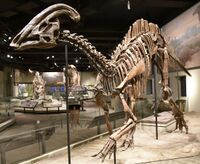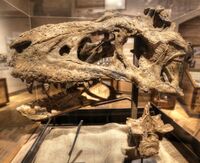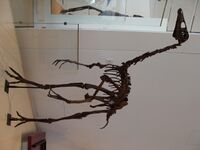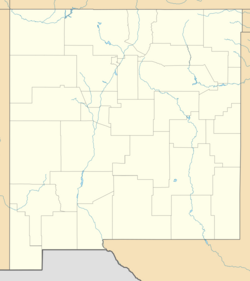Earth:Fruitland Formation
| Fruitland Formation Stratigraphic range: Campanian[1] ~76.3–75 Ma | |
|---|---|
 Fruitland Formation at its type location north of Fruitland, New Mexico | |
| Type | Geological formation |
| Sub-units | Fossil Forest Member Ne-nah-ne-zad Member |
| Underlies | Kirtland Formation |
| Overlies | Pictured Cliffs Sandstone |
| Lithology | |
| Primary | Sandstone |
| Other | Shale, coal |
| Location | |
| Coordinates | [ ⚑ ] : 36°45′07″N 108°26′31″W / 36.752°N 108.442°W |
| Paleocoordinates | [ ⚑ ] 43°30′N 79°36′W / 43.5°N 79.6°W |
| Region | |
| Country | |
The Fruitland Formation is a geologic formation found in the San Juan Basin in the states of New Mexico and Colorado, in the United States of America . It contains fossils dating it to the Campanian age of the late Cretaceous.[2]
The Fruitland Formation shares its name with Fruitland, New Mexico. That city is on what was the western shore of the Western Interior Seaway.[3]
Description
The Fruitland Formation is a sedimentary geological formation containing layers of sandstone, shale, and coal. It was laid down in marshy delta conditions, with poor drainage and frequent flooding, under a warm, humid and seasonal climate.

The Fruitland is underlain by the Pictured Cliffs Sandstone, and overlain by the more recent Kirtland Formation. The sequence of rocks represents the final filling of the Cretaceous seaway. The underlying Pictured Cliffs is a marginal marine sandstone, deposited in an environment similar to offshore barrier islands of the southeast United States . As the seaway retreated, the Pictured Cliffs was covered by the Fruitland Formation, which was deposited in near-shore swampy lowlands. The formation is dated to the late Campanian (part of the Cretaceous period), and was deposited over a period of about a million years. Radiometric dating from 23 meters above the base of the formation has yielded an age of 76.03 ± 0.41 Ma ago. An ash bed lying above the upper boundary with the Kirtland Formation has been dated to 75.02 ± 0.13 Ma ago. The underlying Pictured Cliffs Sandstone would be dated 76.94 - 76.27 Ma, based on the presence of the ammonite Baculites scotti, therefore placing the base of the Fruitland Formation at ~76.3 Ma.[4]
The formation is subdivided into the upper Fossil Forrest Member (deposited between about 75.5-75 million years ago) and the lower Ne-nah-ne-zad Member (deposited from 76.3-75.5 million years ago). The Fossil Forrest member is considered to be part of the Hunter Wash, fauna shared with the overlying lower Kirtland Formation.[1]
Paleofauna
Ornithischians
| Ornithischians of the Fruitland Formation | ||||||
|---|---|---|---|---|---|---|
| Genus | Species | Member | Abundance | Notes | Images | |
| Hadrosauridae indet.[5] | Intermediate[5] | Fossil Forest[5] | One print[5] | Giant hadrosaur track, indicating an individual larger than Shantungosaurus, the largest known hadrosaur.[5] |
   | |
| Parasaurolophus[6] | P. cyrtocristatus[6] | Fossil Forest[6] | A partial skull associated with a mostly complete postcranial skeleton, and a partial skull and fragmentary ribs of a juvenile individual.[6] | A lambeosaurine hadrosaurid also known from the Kaiparowits Formation.[6] | ||
| Pentaceratops[7] | P. sternbergii[7] | Fossil Forest[7] | [Two] nearly complete skulls and a nearly complete frill.[7] | A chasmosaurine ceratopsid also known from the Kirtland Formation.[7] | ||
| Stegoceras[8] | S. novomexicanum[8] | Fossil Forest[8] | Partial remains of [three] frontals and nearly complete frontoparietal.[8] | A basal pachycephalosaurid also known from the lower Kirtland Formation.[8] | ||
| Titanoceratops[9] | T. ouranos[9] | A partial skull, syncervical vertebrae, cervical vertebrae, dorsal vertebrae, sacral vertebrae, caudal vertebrae, ribs, humeri, radius, femora, tibiae, fibula, ilia, ischia, and ossified tendons.[9] | Possibly represents a junior synonym of Pentaceratops, holotype may possibly have come from the Kirtland Formation.[9] | |||
Saurischians
Some remains (OMNH 10131) of Bistahieversor may actually have originated in the upper Fruitland Formation.[10]
| Saurischians of the Fruitland Formation | ||||||
|---|---|---|---|---|---|---|
| Genus | Species | Member | Abundance | Notes | Images | |
| Bistahieversor[11] | B. sealeyi[11] | Fossil Forest[11] | A rostral ramus of a lacrimal, and a partial skull and postcranial skeleton of an adult individual.[11] | A eutyrannosaur tyrannosauroid also known from the Kirtland Formation.[11] |
  | |
| Dromaeosauridae[12] | Indeterminate[12] | Fossil Forest[12] | Numerous isolated teeth.[12] | Indeterminate dromaeosaurid remains.[12] | ||
| Ornithomimidae[12] | Indeterminate[12] | Fossil Forest[12] | Distal end of metatarsals, distal end of a phalanx, and foot-bone fragments.[12] | Indeterminate ornithomimid ornithomimosaur remains.[12] | ||
| cf. Ornithomimus[12] | cf. O edmontonicus[12] | Fossil Forest[12] | A manual ungual.[12] | Material possibly referable to Ornithomimus.[12] | ||
| Indeterminate[13] | Fossil Forest[13] | Isolated teeth.[14] | Formerly identified as Paronychodon sp., referral to Troodontidae doubtful.[15] | |||
Economic geology

The Fruitland Formation contains beds of bituminous coal that are mined in places along the outcrop. Original reserves of coal in the formation have been estimated at 200 billion tons.[16]
Since the 1980s, the coal beds of the Fruitland Formation have yielded large quantities of coalbed methane. The productive area for coalbed methane straddles the Colorado-New Mexico state line, and is one of the most productive areas for coalbed methane in the United States . The methane released from the Fruitland Formation, through oil and gas production and a bit of natural seepage, contributes to the Four Corners Methane Hot Spot.[17][18]
See also
- List of stratigraphic units with dinosaur body fossils
- List of fossiliferous stratigraphic units in Colorado
- List of fossiliferous stratigraphic units in New Mexico
References
- ↑ 1.0 1.1 Sullivan, R.M.; Lucas, S.G. (2006). "The Kirtlandian land-vertebrate "age" – faunal composition, temporal position and biostratigraphic correlation in the nonmarine Upper Cretaceous of western North America". New Mexico Museum of Natural History and Science Bulletin 35: 7–29. https://books.google.com/books?id=rCDYCQAAQBAJ&q=The+Kirtlandian+land-vertebrate+%22age%22+%E2%80%93+faunal+composition%2C+temporal+position+and+biostratigraphic+correlation+in+the+nonmarine+Upper+Cretaceous+of+western+North+America&pg=PA7. Retrieved 1 September 2021.
- ↑ Fruitland Formation at Fossilworks.org
- ↑ National Geographic Map of the Day, published in May 2014, depicting North America about 77 million years ago; https://twitter.com/natgeomaps/status/1129816543251054592
- ↑ Fowler, Denver Warwick (2017-11-22). "Revised geochronology, correlation, and dinosaur stratigraphic ranges of the Santonian-Maastrichtian (Late Cretaceous) formations of the Western Interior of North America" (in en). PLOS ONE 12 (11): e0188426. doi:10.1371/journal.pone.0188426. ISSN 1932-6203. PMID 29166406. Bibcode: 2017PLoSO..1288426F.
- ↑ 5.0 5.1 5.2 5.3 5.4 Hunt, Adrian P.; Lucas, Spencer G. (2003). "A New Hadrosaur Track from the Upper Cretaceous Fruitland Formation of Northwestern New Mexico". New Mexico Geological Society Field Conference Series 54: 379–381. https://nmgs.nmt.edu/publications/guidebooks/downloads/54/54_p0379_p0381.pdf. Retrieved 1 September 2021.
- ↑ 6.0 6.1 6.2 6.3 6.4 Gates, Terry A.; Evans, David C.; Sertich, Joseph J. W. (2021-01-25). "Description and rediagnosis of the crested hadrosaurid (Ornithopoda) dinosaur Parasaurolophus cyrtocristatus on the basis of new cranial remains" (in en). PeerJ 9: e10669. doi:10.7717/peerj.10669. ISSN 2167-8359. PMID 33552721.
- ↑ 7.0 7.1 7.2 7.3 7.4 Fowler, D.W.; Freedman Fowler, E.A. (2020). "Transitional evolutionary forms in chasmosaurine ceratopsid dinosaurs: evidence from the Campanian of New Mexico". PeerJ 8: e9251. doi:10.7717/peerj.9251. PMID 32547873.
- ↑ 8.0 8.1 8.2 8.3 8.4 Steven E. Jasinski; Robert M. Sullivan (2011). "Re-evaluation of pachycephalosaurids from the Fruitland-Kirtland transition (Kirtlandian, late Campanian), San Juan Basin, New Mexico, with a description of a new species of Stegoceras and a reassessment of Texascephale langstoni". Fossil Record 3. New Mexico Museum of Natural History and Science, Bulletin 53: 202–215. http://www.robertmsullivanphd.com/uploads/164._Jasinski_and_Sullivan__Stegoceras__COLOR.pdf. Retrieved 2011-08-25.
- ↑ 9.0 9.1 9.2 9.3 Longrich, N.R. (2011). "Titanoceratops ouranos, a giant horned dinosaur from the Late Campanian of New Mexico". Cretaceous Research 32 (3): 264–276. doi:10.1016/j.cretres.2010.12.007. Bibcode: 2011CrRes..32..264L.
- ↑ Carr, T.D. and Williamson, T.E. (2010). "Bistahieversor sealeyi, gen. et sp. nov., a new tyrannosauroid from New Mexico and the origin of deep snouts in Tyrannosauroidea." Journal of Vertebrate Paleontology, 30(1): 1-16. doi:10.1080/02724630903413032
- ↑ 11.0 11.1 11.2 11.3 11.4 Carr, Thomas D.; Williamson, Thomas E. (2010). "Bistahieversor sealeyi, gen. et sp. nov., a new tyrannosauroid from New Mexico and the origin of deep snouts in Tyrannosauroidea". Journal of Vertebrate Paleontology 30 (1): 1–16. doi:10.1080/02724630903413032. Bibcode: 2010JVPal..30....1C. https://www.tandfonline.com/doi/pdf/10.1080/02724630903413032?needAccess=true.
- ↑ 12.00 12.01 12.02 12.03 12.04 12.05 12.06 12.07 12.08 12.09 12.10 12.11 12.12 12.13 12.14 Lucas, Spencer G.; Mateer, Niall J.; Hunt, Adrian P.; O'Neill, F. Michael (1987). "Dinosaurs, the age of the Fruitland and Kirtland Formations, and the Cretaceous-Tertiary boundary in the San Juan Basin, New Mexico". The Cretaceous-Tertiary Boundary in the San Juan and Raton Basins, New Mexico and Colorado. Geological Society of America Special Papers. 209. pp. 35–50. doi:10.1130/SPE209-p35. ISBN 0-8137-2209-8. https://pubs.geoscienceworld.org/books/book/342/chapter/3796215/Dinosaurs-the-age-of-the-Fruitland-and-Kirtland.
- ↑ 13.0 13.1 Cite error: Invalid
<ref>tag; no text was provided for refs namedfruitland - ↑ David C. Evans, Derek William Larson, Thomas Michael Cullen & Robert M Sullivan (2014) ‘Saurornitholestes’ robustus is a troodontid (Dinosauria: Theropoda). Canadian Journal of Earth Sciences 51: (7): 730-734. doi: 10.1139/cjes-2014-0073 http://www.nrcresearchpress.com/doi/abs/10.1139/cjes-2014-0073
- ↑ David C. Evans, Derek William Larson, Thomas Michael Cullen & Robert M Sullivan (2014) ‘Saurornitholestes’ robustus is a troodontid (Dinosauria: Theropoda). Canadian Journal of Earth Sciences 51: (7): 730-734. doi: 10.1139/cjes-2014-0073 http://www.nrcresearchpress.com/doi/abs/10.1139/cjes-2014-0073
- ↑ Fassett, James E.; Hinds, Jim S. (1971). "Geology and Fuel Resources of the Fruitland Formation and Kirtland Shale of the San Juan Basin, New Mexico and Colorado". U.S. Geological Survey Professional Paper. Professional Paper 676. doi:10.3133/pp676.
- ↑ Fenton, James (May 12, 2016). "Geologist: Coal outcrops cause methane hot spot" (in en). https://www.daily-times.com/story/money/industries/oil-gas/2016/05/12/geologist-coal-outcrops-cause-methane-hot-spot/84291088/.
- ↑ Elliott, Dan (2016-08-15). "Methane "hot spot" over Four Corners linked to oil, gas production sites" (in en-US). https://www.denverpost.com/2016/08/15/four-corners-methane-hot-spot-linked-to-oil-gas/.
 |



